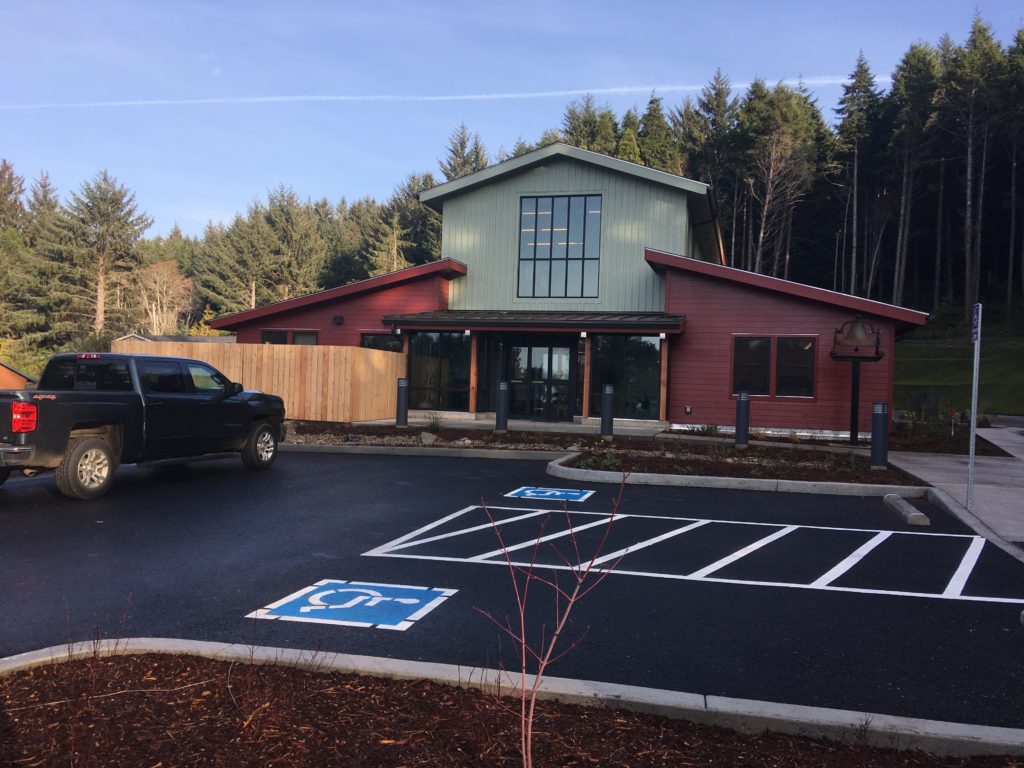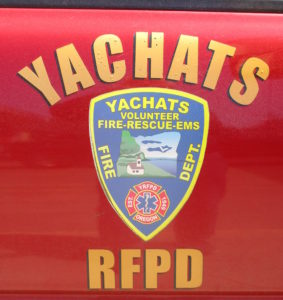
By QUINTON SMITH/YachatsNews.com
The Yachats Rural Fire Protection District board has tapped the brakes on a suggestion to ask voters in May to approve a new tax levy to hire more people and replace old equipment.
The board held a special meeting Monday to discuss the idea of putting an operating levy on the May ballot, allowing it to hire 2.5 firefighter/paramedics and possibly replace a 40-year-old pumper.

The idea was brought up months ago by new board member Drew Tracy, a retired police chief with deep background in administration, training and incident command. He believes – and the board generally agrees – that the Yachats department is understaffed to respond to overlapping calls or large events, cannot staff its small station east of Yachats, and too often depends on help from the fire departments in Waldport and Seal Rock.
But three other board members and district administrator Frankie Petrick felt getting a levy on the May ballot did not leave enough time to convince voters why it’s needed.
“There’s no way we can accurately educate district voters to make the May election … particularly when we would be adding taxes,” Petrick told the board.
Two board members also felt they did not have good enough financial information from administrators to decide in February to get on the May ballot. So, they asked for:
- How the recent completion of $80,000 yearly payments to buy the land for its new fire station will affect its operating budget. Petrick and board members conceded that using operating funds to purchase the property was a mistake, when that cost should have been wrapped into the $7.7 million bond approved by voters in 2016.
- How much it should be putting aside each year to replace fire equipment. Petrick and board members admitted there is no such savings plan for fire rigs that can cost as much as $650,000 to buy or $70,000 a year to lease.
- The amount of money it could save by adding firefighter/paramedics rather than paying overtime.
- A general idea of how much it might get from the sale of its former station in downtown Yachats – it will go on the market soon — and how that money could be used.
- Some sort of plan to hire a salaried fire chief once Petrick, 76, who is paid as district administrator and serves as a volunteer chief, retires.
“Why did we wait so long to do this,” asked Betty Johnson, a longtime Yachats resident who has been on the board for 12 years.
District has large tax bite
Although it has a low profile, the fire district is the third largest user of property taxes in the Yachats area, following the Lincoln County School District and Lincoln County government. For 2020-21, 16 percent of all property taxes paid by a Yachats resident went to the fire district via levies or bond.
The fire district currently has two voter-approved five-year operating levies. One carries a tax rate of 61 cents and the other is 59 cents per $1,000 of assessed property value. The district’s permanent tax base, established in 1997, is 29 cents. The district’s fire station bond carries a rate of 65.8 cents per $1,000 assessed value.
In all, its levies and bond total $2.15 per $1,000 assessed value – or $752 a year on property worth $350,000.
The district has a $1.82 million yearly budget, two administrators, two part-time employees and six career firefighters who provide service 24 hours a day, 365 days a year. The district runs from south of Yachats, up the Yachats River and north to the Waldport city limits.
The district has a small station seven miles up the Yachats River that is not staffed, which will affect insurance ratings for property in that area if not corrected.
Fire staff stretched very thin
In a presentation to the board, Tracy said the department enjoys strong support from the community and has good response times for fire and ambulance calls. But its staffing has remained at the same level for 10 years while the number of volunteers has dropped to three – including Petrick and assistant administrator Shelby Knife — and the number of calls has doubled to more than 900 a year.
If two paramedics are transporting a patient to the hospital in Newport, there is no one except volunteers to cover other calls until they return.

“We have mutual aid agreements, however we should not be relying on these agencies on a daily basis,” Tracy said in his presentation. “We don’t have staffing for multiple calls.”
The district also pays lots of overtime — although administrators had no numbers — and scramble to fill shifts when there are vacations, illness and staff emergencies.
“We have limited backup capabilities on the coast … we just need to make it more robust,” he said.
The cost of a firefighter/paramedic – including salary, retirement and insurance benefits, and gear is about $100,000 a year. A 1971 engine/pumper the department bought used would cost $650,00 to replace – but there is no plan or savings to do so, he said.
In his presentation, Tracy presented a range of tax rates to give other board members an estimate of what a third levy might add.
At the highest, a levy of 70 cents per $100,000 assessed property value would raise about $382,000 a year and cost the owner of a $400,000 home $280 more a year. A levy of 40 cents would raise $218,000 a year, costing the owner of the same property $160 more a year.
If voters approved the levy in May, the county would begin collecting it in November, providing an immediate, new revenue stream for the district.
Ed Hallahan, who is the longest-serving member of the board and oversaw the district’s bond campaign and station construction, said he was reluctant to add a third operating levy. Instead, he wondered if waiting until May 2022 when an existing levy is scheduled to come up for a vote – and just increase it – would be viewed more favorably by voters.
Or, if the board decided in the next few months that it wanted to go ahead with a third levy, Hallahan said, a vote in November would provide enough time to gather all the data and run a campaign.
“I’d love to have the money sooner,” he said, “but I worry about having three levies out there.”



I am not a resident of Yachats. I live in unincorporated Lincoln County. We recently passed a Bond Measure for our Fire District.
Although I voted for the Bond Measure, I would have appreciated it if the District had told us how much of the increase was due to STRs. Were I in the Yachats District, I would want to know. This is why I think this important information for Yachats District:
According to the Lincoln County Sheriff’s STR Planning Report, dated July 9, 2020, the STRs licensed in the unincorporated areas of the 97498 zip code, added 143 rental bedrooms with a maximum occupancy of 498.
I don’t know where along the estimated 50 miles of roads in 97498 the STRs are located. The Fire District should know because the Sheriff is required by law to give the addresses and the licensed occupancies of all STRs in unincorporated Lincoln County to the Fire Districts. Someone more familiar with south County could probably figure it out by the addresses on the County’s website. https://www.co.lincoln.or.us/sheriff/page/short-term-rental-licensing
The Fire District would also know how many call-outs were to STRs. In my Fire District, call-outs to STRs were so frequent that they caused a significant increase in response times. Also, not enough trained volunteers who had recently completed 3 years of training at taxpayer expense could be retained. No public official will say it, but the lack of available housing was a factor.
This cost of fire and emergency response vehicles (operation and amortized purchase) and personnel (benefits, salary) is just one example of the hidden costs that this Industry hides from us.
Others include: (1) law enforcement vehicles (amortized purchase & operation) and personnel (salary and benefits), (2) public health-related Infrastructure including roads, public water system and sewer maintenance, (3) loss of tax benefits or credits or loans for public services like schools and hospitals that were based on a full-time resident population, but without housing, the population decreases, (4) available long-term housing for teachers, hospital staff, emergency responders, construction workers, fishermen, seniors, and (5) housing and jobs for graduates from our taxpayer-funded Oregon Coast Community College who graduate with degrees that lead to careers in Nursing and Allied Health, Education, Aquarium Science, Business, and Transfer programs.
And if it is true, as Property Managers and Realtors allege, that an STR will increase property values, of concern to seniors and others on fixed income has to be property taxes.
So, ask for facts and encourage the Fire District Board to drill more deeply into just how the budget is impacted by STRs. Of course, Board members who own STRs should recuse themselves.